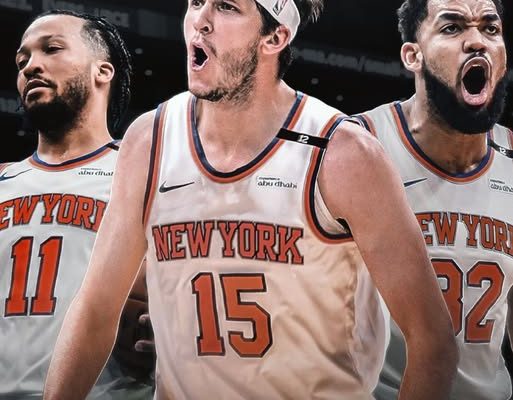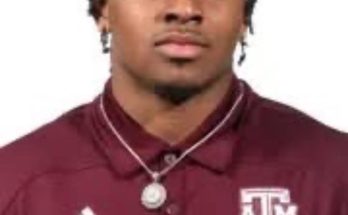The NBA offseason has taken another dramatic turn, and this time it involves two major franchises that are never far from the headlines. According to league sources, the Los Angeles Lakers are trading guard Austin Reaves to the New York Knicks in exchange for center Mitchell Robinson. The deal, which comes as a shock to both fanbases, signals a pivotal shift in direction for both organizations, each of which has its sights set on deep playoff runs in the 2025–26 season. The trade is pending final league approval and physicals but has been confirmed by multiple high-ranking insiders close to both teams.
Austin Reaves, the undrafted Arkansas native who rose from G League obscurity to become one of the Lakers’ most reliable backcourt options, has seen his star steadily rise since joining the NBA in 2021. His development has been a point of pride for the Lakers’ player development staff. Over the past two seasons, Reaves has averaged 15.8 points, 4.3 assists, and 4.1 rebounds while playing alongside LeBron James and Anthony Davis, often serving as a key playmaker and secondary scoring option. His gritty approach, high basketball IQ, and chemistry with the team’s core made him a fan favorite at Crypto.com Arena. Yet in the cutthroat calculus of modern roster building, sentimental value often takes a back seat to strategic needs.
That strategic need for the Lakers appears to be size and interior defense—two qualities Mitchell Robinson provides in abundance. The 7-foot center from Chalmette, Louisiana, has been a force in the paint for the Knicks when healthy, known for his elite shot-blocking, rebounding, and rim-running abilities. Robinson averaged 8.4 points, 8.8 rebounds, and 1.9 blocks per game last season, anchoring a Knicks defense that ranked among the top units in the Eastern Conference. However, Robinson has also struggled with injuries throughout his career, including ankle and foot issues that have sidelined him for chunks of multiple seasons. For the Lakers, the acquisition of Robinson signals a return to traditional roster balance, with a clear desire to put more size around Anthony Davis and reduce his wear and tear at the center position.
For the Knicks, this trade marks a significant pivot. While New York has flirted with multiple trade scenarios over the past few seasons, including those involving Julius Randle and Evan Fournier, this move sends a clear message that the organization is investing heavily in perimeter playmaking and offensive versatility. In Reaves, the Knicks gain a capable secondary ball-handler who can thrive next to Jalen Brunson, allowing the team to initiate offense from multiple angles and create spacing for its other scorers. Reaves’ ability to run the pick-and-roll, hit clutch shots, and defend multiple positions makes him a valuable fit in Tom Thibodeau’s system, which demands effort on both ends of the floor.
The ripple effects of this trade are bound to be far-reaching. For one, it introduces serious questions about the Lakers’ backcourt depth heading into training camp. With Reaves gone and uncertainty lingering around D’Angelo Russell’s long-term fit, the Lakers may be banking on a significant leap from young guards like Jalen Hood-Schifino or even exploring veteran options in the free agent market. There’s also the matter of LeBron James. While he has expressed unwavering confidence in Rob Pelinka and the front office, James was known to have strong on-court chemistry with Reaves. It remains to be seen how he will react to losing one of his most trusted teammates, especially as he enters what could be the final year of his Lakers tenure.
In New York, the acquisition of Reaves likely changes the rotation in significant ways. Josh Hart, Quentin Grimes, and Donte DiVincenzo all played important minutes last season, and adding Reaves to that mix could either create a logjam or raise the ceiling of the team’s backcourt potential. Thibodeau, known for his rigid rotations and defensive demands, will have the luxury—and challenge—of blending Reaves into an already crowded guard rotation. But it also opens up intriguing possibilities, including more small-ball lineups and increased tempo offensively.
From a financial perspective, the trade is relatively balanced. Reaves is entering the second year of a four-year, \$53 million deal that is considered one of the most team-friendly contracts in the league given his production. Robinson, meanwhile, is under contract through 2026 on a descending four-year, \$60 million deal, making him an attractive trade piece due to his age, upside, and cap flexibility. Neither team takes on a long-term financial burden that could cripple future roster moves, meaning this trade gives both franchises flexibility going forward.
This transaction also underscores a growing trend in the NBA: the constant reevaluation of talent in service of maximizing windows of contention. The Lakers are clearly all-in on surrounding Anthony Davis with more size and rim protection, particularly in the wake of their playoff exit, which saw them exposed defensively in the paint during key stretches. By acquiring Mitchell Robinson, they hope to reinforce their interior defense and reduce the pressure on Davis to anchor every possession. If Robinson can stay healthy, his impact could be immediate and transformative.
For the Knicks, this is about unlocking a new gear offensively. With Jalen Brunson emerging as a star in the Eastern Conference, Reaves gives New York another option to handle the ball, stretch the floor, and create mismatches. While Robinson’s shot-blocking will be missed, the Knicks may lean more heavily on Isaiah Hartenstein or possibly explore small-ball looks with Randle at the five. Reaves’ presence also gives the Knicks a closer—a player capable of taking and making big shots in playoff situations, something that proved elusive at times in past postseason runs.
NBA insiders have long speculated that the Lakers might be eyeing a significant roster shakeup this summer, particularly after their second consecutive early playoff exit. There were whispers about Reaves being untouchable, but ultimately, Pelinka and his front office made the calculation that a high-upside center like Robinson could have more long-term value. Meanwhile, Leon Rose and the Knicks front office, emboldened by last year’s strong regular season and playoff performance, appear ready to take the next step by upgrading their offensive backcourt and banking on internal development for frontcourt depth.
Fan reaction, as expected, has been polarizing. Lakers fans are stunned to see Reaves go, especially given how organically he rose through the ranks and how beloved he had become within the fanbase. Social media was immediately flooded with tributes, memes, and debates over whether the deal was worth it. Knicks fans, on the other hand, have expressed cautious optimism. While many appreciated Robinson’s contributions, they also recognize the need to improve shot creation and perimeter playmaking to compete with the top-tier teams in the East.
This deal may not be the last for either franchise. Sources say both the Lakers and Knicks are still active in trade discussions, with Los Angeles monitoring the availability of other wings and the Knicks keeping tabs on the Joel Embiid situation in Philadelphia. The timing of this trade, so close to the start of training camp, indicates a sense of urgency to establish new identities ahead of what is shaping up to be one of the most competitive seasons in recent memory.
In the end, the Lakers betting on Robinson’s interior dominance and the Knicks doubling down on backcourt skill reflect two differing philosophies, but with the same goal: championship contention. Only time will tell which side wins this trade, but for now, the NBA world is once again reminded that no one is ever truly untouchable, and in a league driven by matchups and margins, bold moves are the price of ambition.



